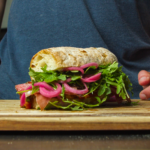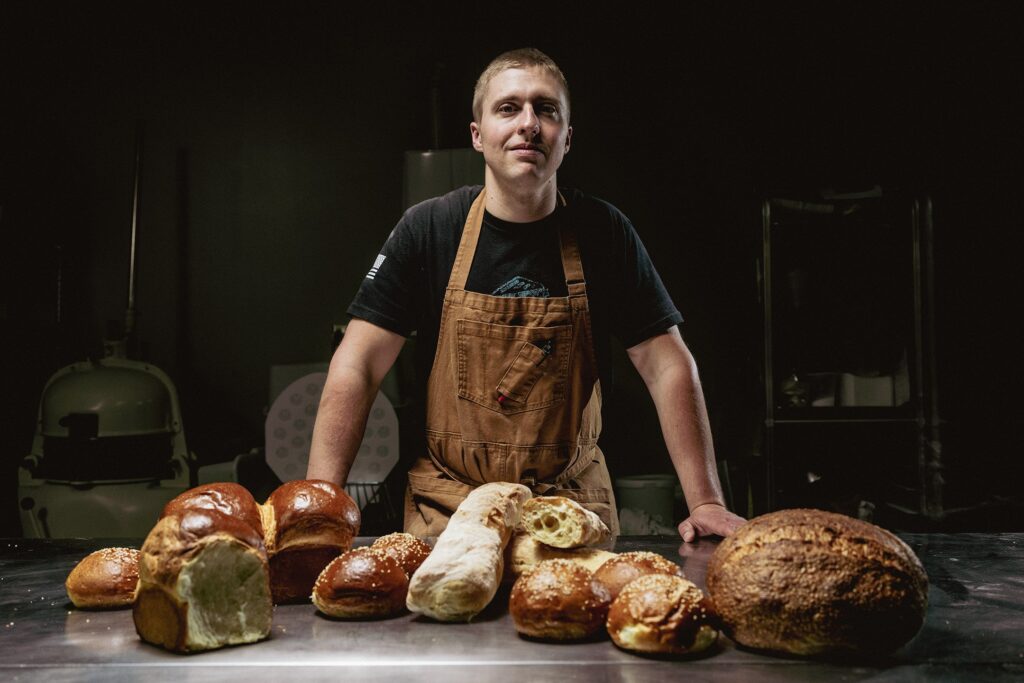Baking for the Kingdom: An Interview with John Gassner
Recipe for John’s Salami & Hot Honey Sandwich included below! It’s 6 am, and as thoughts of yeast ratios and rising times flit through his head, John Gassner lifts weights in the gym. After working out, John embarks on the rest of his 17-hour day, most of which centers around baking what he believes is […]



Recipe for John’s Salami & Hot Honey Sandwich included below!
It’s 6 am, and as thoughts of yeast ratios and rising times flit through his head, John Gassner lifts weights in the gym. After working out, John embarks on the rest of his 17-hour day, most of which centers around baking what he believes is “the highest quality, best tasting, and best-looking bread” in his corner of Virginia.
The focus is working towards the motto “bread with integrity,” he says, and while “it’s a constant journey, striving to bake bread that enjoyably fuels families everyday,” it is also one he passionately loves. Ultimately, he hopes to create a bakery where premium quality and affordable prices are a testament to the ideals of the Catholic faith.
Now the owner and founder of Working Man Bread Co., John explains that it wasn’t until a camping trip in high school that he discovered how motivating cooking could be. “I was on the high school ‘come and see’ summer program at Wyoming Catholic College,” he recounts, and in the course of a backpacking hike, the guys “threw all the rations into one pot—three different noodles and cheese powders, summer sausage, bacon, pepperoni, the entire spice kit, and cheddar guppies.” While many would probably be repulsed by that, John says, “you get it if you’re a starving guy in the backcountry!”
This “act of creating something spectacular from not a whole lot” spurred John on: “I went home and asked my mother to teach me how to cook. I voraciously began consuming cookbooks and found a job as a dishwasher in a restaurant.” During his time in college—which turned out to be Wyoming Catholic—he continued honing his skills with various jobs and friends, ferreting out the secrets of pastry baking at a local cafe, working in the cafeteria, and throwing sumptuous parties for faculty and staff.
John had wanted to enter the Marines straight out of high school, but as his dad told him, “If you’re gonna get shot at, you ought to go to college and become an officer and make more money doing so.” At first begrudgingly, John looked into colleges and was “blown away with the caliber” of the Wyoming Catholic students he met. “I knew I needed to have whatever nameless quality they had about them and that sealed the deal.”
Having graduated college in 2021, John returned to his original idea and entered the Marine Corps Officer Candidate School, but after two months he was medically dropped after suffering heat stroke during an intense training run.
He now found himself “on an accelerated timeline” towards his next dream: opening a restaurant. “I decided to pursue a sandwich food truck as a way to build up to the undertaking of launching a restaurant; however, I did not have the funds to buy one.” John started baking out of his parents’ kitchen to save up. “I began teaching myself, posting on social media and (probably illegally at first) selling my bread. I’d put like 24 hours into baking two loaves by hand and then drive 40 minutes one way to drop a loaf at a stranger’s house in exchange for ten dollars. It was pretty ridiculous, now that I think about it.”
However ridiculous John might feel his beginnings were, the quality of his baking quickly attracted the attention of local restaurant owners. Growing with incredible speed, John’s business—recently rebranded as Working Man Bread Co.—supplies about 16 restaurants and stores, with a select number of specialty breads. “We do farmers markets on the weekends,” John explains. While it varies for each location, the primary top-selling types of bread are Japanese Milk Bread Buns, Rustic Ciabatta, and a Naturally Leavened Rye and Whole Wheat sourdough.
“The most satisfying part is when I get to deliver bread,” John says. “I get to speak with the various people that work at all the places [we deliver to] and see what they’re up to.”
He also loves getting “absorbed in the minutiae” that differentiates his bread from any other. There are “so many different variables to nail down, and you must use intuition and your senses—not just formulas repeated robotically.” The dough can be different each day, he notes.
Part of his project is specifically health oriented and, through that, God oriented: “You don’t realize how compromised our food supply is until you’re in it, and pricing is an indicator. The very thing we rely on to fuel everything else in our lives is quite compromised.” With factory produced bread, “many questionable ingredients are specifically—often synthetically—formulated to eliminate natural ingredients and drive the cost down and profits up, stripping the bread of any nutritional benefit and replacing it with deleterious effects.” It takes some convincing to “justify to restaurants that the bread we bake—which is an incredible value and hinges on time and ingredients God created—is worth it.”
John believes that food should be affordable for families to buy daily while also possessing integrity. “I think we’re all familiar with attending a farmers market, wincing with our wallets in hand, if we hope to eat without resigning ourselves to the Safeway.” Although it’s a problem he has not yet solved, John believes it will come with adoption and time: “As food becomes decentralized and more local producers pop up, competition can drive creative solutions amongst producers that care what you put in your body, and that will eventually reconcile the disparity.”
This avid young baker seeks to “foster a workplace where classical conversations are the norm and which tangibly bolsters our faith.” He continues: “I’d like to restructure baking schedules to automatically give my employees Holy Days of Obligation off. Also, if an employee wants to go to confession or Mass during their shift, I’d like to create some way for them to discreetly and feasibly make that happen.”
At the end of the long day (evening deliveries end around 8pm, after which John still has to feed himself and the sour-dough starters), his “big goal of baking” is “to coalesce the principles of classical western tradition with the fundamental nourishment of food in an exciting way that creates room for honest conversations as a way of restoring Christian culture.” These ideas, born of conversations, reading, and deep thought, lead John to think that artisan bread ultimately has the power to “feed both body and soul.”
John’s Recipe for a Salami & Hot Honey Sandwich
Origins
“In Wyoming, there is a bar called ‘The Gannett’ (after one of the state’s most formidable mountain peaks). It’s the go-to spot for any celebration. One of their dishes is a crispy sourdough crust pizza topped with garlic, salami, hot honey, fresh mozzarella, and arugula. They call it the ‘Stinger.’ One of my friends would always order this pizza but sub out the cheese for goat cheese. This sandwich is a riff on that memory. There’s a bit of prep, but once you have these ingredients, you’ll find yourself putting them on a whole bunch of other things. Plus, the sandwich itself comes together in under a minute—just freestyle the amounts to your own liking!”
Ingredients
- Good quality Ciabatta (preferably sourdough)
- An Assortment of Salami (pick whatever you like, but I like a combo of genoa, peppered and calabrese)
- Plain Goat Cheese
- Arugula
- Pickled Red Onions (Instructions Below)
- 1 medium red onion
- 1 cup apple cider vinegar
- 1 cup water
- 1 tablespoon sugar
- 1 1/2 teaspoons salt
- Tomato Jam (Instructions Below)
- 1 28-ounce can San Marzano tomatoes
- 5 garlic cloves, chopped
- 1 jalapeño pepper, chopped
- 1/4 cup pure maple syrup
- 1/4 cup apple cider vinegar
- 1/4 cup extra-virgin olive oil
- 1 teaspoon hot sauce
- 1/4 cup chopped fresh cilantro
- Salt
- Hot Honey (Instructions Below)
- 1 C. Honey
- 1-2 Tbsp red pepper flakes (adjust to taste)
- 1 tsp crushed garlic
- 1 Tbsp apple cider vinegar
Sandwich Assembly Instructions
Halve the ciabatta and spread a layer of tomato jam on the bottom side. Layer a generous amount of salami in shingles. Top the salami with a few crumbles of goat cheese. Drizzle a bit of hot honey over the goat cheese and top with arugula and pickled red onions.
Pickled Red Onion Instructions
- Peel and slice the onion into rings or strips.
- To make the brine, combine all ingredients (except for the onion) in a medium saucepan, and heat until the sugar and salt are fully dissolved and it comes to a low simmer.
- Pour the brine over the onions in a heatproof container and let cool.
Hot Honey Instructions
- In a small saucepan, combine the honey, red pepper flakes, and garlic.
- Heat the mixture over medium-low heat, stirring occasionally. Do not bring to a boil; you just want to warm it enough to infuse the flavors.
- Let the honey simmer for about 5-10 minutes.
- Remove from heat and add vinegar.
Tomato Jam Instructions
- Preheat the oven to 350° F.
- Crush the tomatoes by hand, and let them drain in a colander for 30 minutes in order to remove as much liquid as possible.
- Toss all ingredients together (except the cilantro) and spread the mixture evenly on a rimmed baking sheet. Bake until the liquids have reduced, the tomato is slightly browned, and the garlic is soft, about 45 minutes.
- Cool, add cilantro, and adjust salt to taste.
Photos provided by the author















